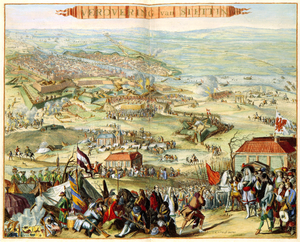Siege of Szczecin (1677)
| date | June 25, 1677 to December 15, 1677 |
|---|---|
| place | Szczecin , Swedish Pomerania |
| output | Victory of Brandenburg-Prussia, conquest of the fortress |
| Parties to the conflict | |
|---|---|
| Commander | |
|
Lieutenant General Jacob Johann von Wulffen |
Elector Friedrich Wilhelm |
| Troop strength | |
| 3400 Swedes 2000 citizens militia |
16,226 to 26,000 Brandenburgers 4–6,000 Lüneburgers 2,000 Danes 300 Croatians |
| losses | |
|
3,000 dead, wounded, sick Sweden |
10,000 dead, wounded, sick Brandenburgers |
Northern War (1674–1679)
Rathenow - Nauen - Fehrbellin - Wismar - Wolgast 1675 - Wolgast 1676 - Bornholm - Öland - Peenemünder Schanze - Stettin (1676/77) - Køgebucht - Bergen - Warksow - Rügen (1678) - Stralsund (1678) - Greifswald - Tilsit - Splitter - Telschi - Porta Westfalica
In the siege of Stettin (1677) in the Northern War from 1674 to 1679 , a Brandenburg - Danish - Lüneburg army besieged and conquered the Swedish-Pomeranian city of Stettin from June 25, 1677 to December 15 (July) 1677.
prehistory
After the Peace of Westphalia , Western Pomerania and Rügen , the port city of Stettin, the estuary of the Oder and a strip of land on the eastern bank of the Oder were awarded to Sweden . After his victory at Fehrbellin , Brandenburg took Wollin and Wolgast in the same year . In 1676, Anklam and Demmin were conquered for Brandenburg. Only Stettin and also Rügen, Stralsund and Greifswald remained in Swedish hands as larger towns in Swedish-Pomerania .
The city itself had a population of 10,900 in 1709, making it one of the largest cities bordering the Baltic Sea. The city controlled the estuary of the Oder and the shipping traffic to and from the Baltic Sea. It was therefore of great strategic value for the Elector of Brandenburg, as he was striving for unhindered access to the Baltic Sea. Since the sea battle in the Køgebucht in July 1677, the Allies had command of the sea in the southern Baltic Sea and blocked the shipping of Szczecin with the Swedish motherland. A successful relief from the sea side could thus be effectively prevented.
Stettin had extensive fortifications , which prevented a quick occupation. The fortress formed a square, of which the Oder formed one side. From September 16 to November 16, 1676, Stettin was besieged in vain by Brandenburg troops.
course
In July 1677, according to other information, 26,000 Brandenburg soldiers moved 16,226 men in 9 cavalry regiments and 16 infantry regiments under the personal command of Elector Friedrich Wilhelm I before Stettin. The Allied army had a large artillery park with over 200 cannons and large amounts of ammunition, which were brought over the Oder from the armory of Berlin and Magdeburg . Another five Lüneburg regiments with 4,000–6,000 men, later a Danish division of 2,000 men and 300 Croats, reinforced the siege army. The city was defended by a garrison of 3,200-3400 men in five regiments, commanded by Lieutenant General Jacob Johann von Wulffen . In addition, around 2,000 city militias strengthened the garrison in eleven companies.
The garrison of the city of Szczecin defended itself resolutely in unanimous cooperation with the citizens. For four months from August to December 1677 the city was bombarded intensively, so that at the end of the siege only 20 undamaged houses remained in Szczecin. At the end of December, the sappers managed to blow up part of the main wall. A major breach had been made in the fortification. The Allies were already preparing for the decisive assault. It was only at this point in time that Lieutenant General von Wulffen surrendered. At the time of the surrender, the crew had only small reserves of ammunition and consisted of only about 300 men. In the terms of surrender, she received the right to withdraw from the national Swedish part of the crew. 2443 citizens of the city were killed during the siege. All privileges have been confirmed to the city. On January 6, 1678, Elector Friedrich Wilhelm moved into the city.
consequences
According to the provisions of the 1679 Treaty of Saint Germain between Brandenburg and Sweden , Brandenburg had to return all of its conquests to Sweden with the exception of a strip of territory to the right of the Oder. The Brandenburgers left Stettin last.
literature
- Georg Hiltl : The great elector and his time. 1893.
- Louis von Malinowsky: History of the Brandenburg-Prussian artillery. Volume 3, Duncker & Humblot, 1842, pp. 122-142.
- Ernst Friedrich Christian Müsebeck: The campaigns of the great elector in Pomerania, 1675–1677. Printed by Herrcke & Lebeling, Stettin 1897.
- Fr. Thiede: Chronicle of the City of Stettin: edited according to documents and the tried and tested historical news. Published by Ferdinand Müller, Stettin 1849.
Web links
Individual evidence
- ↑ Ernst Völker: Stettin - data and images on the city's history. G. Rautenberg, Leer 1986, ISBN 3-7921-0317-6 .
- ^ Georg Hiltl : The great elector and his time. 1893, p. 339.
- ↑ E. Muse Beck: The campaigns of the Great Elector in Pomerania, 1675-1677. Herrcke & Lebeling in Stettin, 1897, pp. 133-134.
- ^ Fr. Thiede: Chronicle of the City of Stettin: edited according to documents and the tried and tested historical news. Published by Ferdinand Müller, Stettin 1849, p. 734.
- ^ Fr. Thiede: Chronicle of the City of Stettin: edited according to documents and the tried and tested historical news. Published by Ferdinand Müller, Stettin 1849, p. 735.
- ^ Georg Hiltl : The great elector and his time. 1893, p. 346.
- ^ Fr. Thiede: Chronicle of the City of Stettin: edited according to documents and the tried and tested historical news. Published by Ferdinand Müller, Stettin 1849, p. 754.
